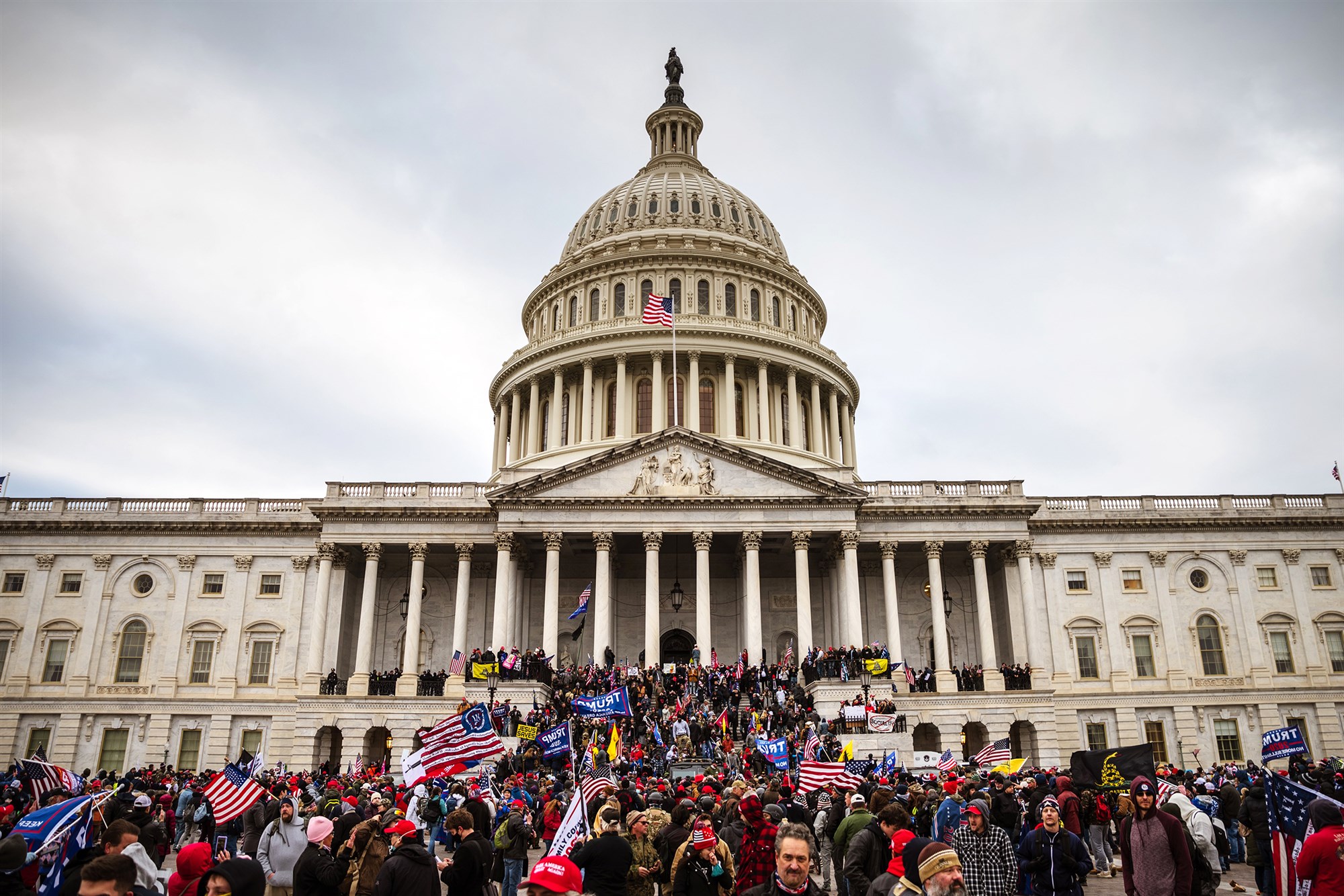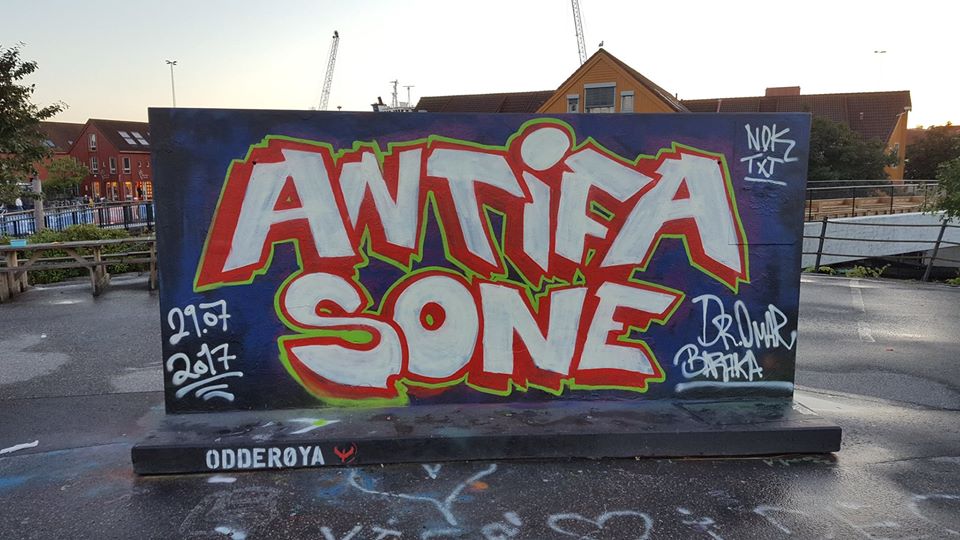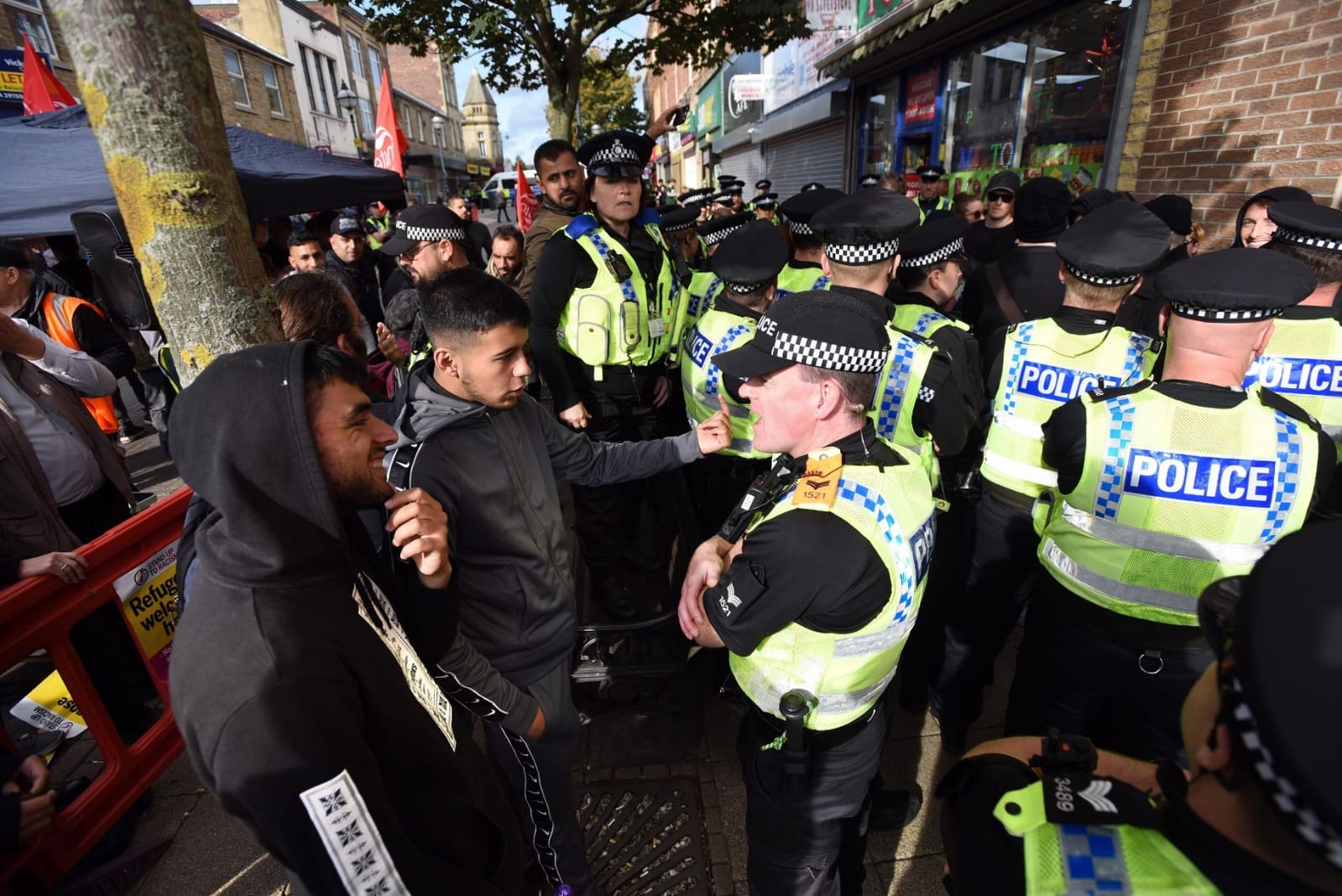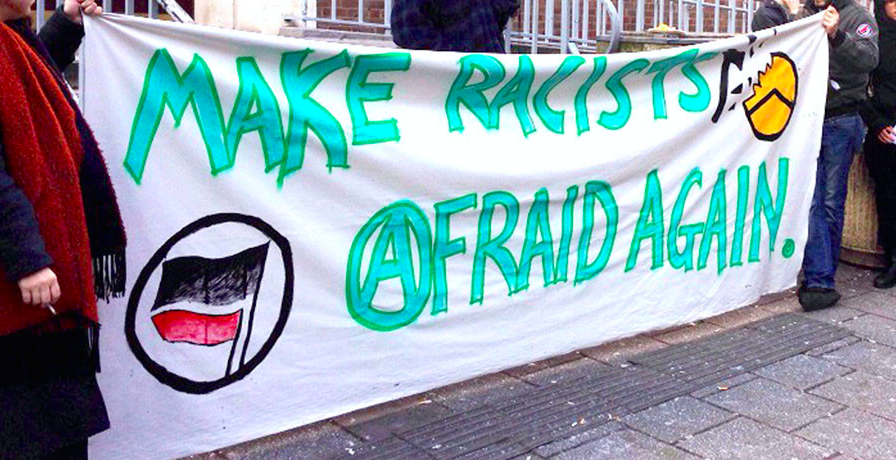The following article was written by Brighton Antifascists.
On the 4th October 1936, tens of thousands of anti-fascists turned out to stop Mosley’s Blackshirts marching into the East End of London. Nevertheless, Mosley was able to carry on recruiting and indeed marched again within the week. A year later, an equally large march was met with similarly fierce opposition in Bermondsey. It was one battle in an ongoing campaign: fascism isn’t that easy to put down. Anti-fascism is never just ‘the big demo’.
Mosley, in common with the other fascist leaders, understood the value of the mass demonstration. Even in this online era the physical coming together of an ideology to take space, even better ‘foreign’ space, is powerful. Marching into areas perceived as alien, with police assistance (it is important that the state acts as a “neutral” facilitator) confrontation of some sort can be guaranteed. The events of the day, unless disastrous, gain press coverage and boost the overall movement.
The most recent example of a mass movement dedicated to taking ‘foreign space’ here, was the English Defence League. Originating from a local dispute in Luton, where jihadist group Al Mujahiroun disrupted the homecoming parade of the local regiment, the EDL were able to take advantage of strains of Islamophobia, ultra nationalism and racism to rapidly build their movement. Between 2009 and 2012 the EDL were demonstrating around once a month somewhere in the country. Their M.O was to head to a town with a large Muslim/Asian population for a large flag waving intimidatory demo. These demos, although organised with the police were large (often over a thousand), disorderly and violent. They drew on wide layers of society far beyond neo-nazi cranks. The rhetoric that they drew from around ‘the war on terror’ had been prepared by the media and Labour government for nearly a decade.
Realistically at the time (in contrast to today’s often smug “Just punch them in the face” social media rhetoric) neither anarchists or the rest of the left had the wherewithal to successfully counter-mobilise. There were good examples of community self defence, (e.g Bradford in 2010) but the left’s contribution was either tiny or actually counter-productive in the sense of trying to dissipate energy by organising rallies miles from the EDL.
The inability of the Left, to confront this modern day “King & Country” mob (as well as the the fact that some far-right factions began attacking left meetings) led to some anarchist and left activists organising the Anti Fascist Network.
This upped the ante. Not every outing was a glorious victory and it should be said that the AFN always performed best in towns where there was strong left base e.g Brighton, Bristol, Liverpool, London but the arrival of a more militant approach, aimed at mass community mobilisation, did change the game. Even on days where there was no direct confrontation the police, nation wide, adopted a strategy of utilising massive numbers, relocating the EDL marches to out of town sites and kettling both sides. The monotony of the average EDL demo then began to tell and numbers fell into a steep decline.
However, the door had been wedged open. We saw the return of openly Nazi groups, such as National Action to the streets for “White man marches”. The National Front crawled back out of the sewer and joined up with groups that had splintered from the EDL, like the South East Alliance and the various Infidel groupings. They all subscribed to overtly white supremacist beliefs.
These groups were smaller, confined by their more overtly extremist rhetoric and quite frankly poor leadership. There were numerous confrontations with militant anti-fascists, most notably in the town of Dover (although a mention in dispatches must go to the stinging defeat suffered by National Action in Liverpool in 2015). The riot in January 2016 that saw several hours of hand to hand fighting between ‘Unite the Right’ and anti fascists lead to hefty prison sentences being handed out to both sides, although primarily it was the right that really copped it with some sentences ranging as high as seven years.
So where are we now then?
Right now, the fascists are in some disarray. This has bred a level of complacency among the left as we share “Good Night, Alt Right” memes or joke on platforms about how much fun it is to “punch a Nazi”. There are however still fascist marches and events happening regularly around the country, often opposed by just a handful of locals. Tommy Robinson recently threw his hat into the ring again in Manchester and pulled a crowd of 1,500. While many would have been ordinary mancunians who wanted to show solidarity with the victims of the recent terror attacks, many were ex EDL.
Tommy’s also been busy up in Sunderland, exploiting the alleged sexual assault of a young woman by four refugees. Two large demonstrations and large scale community support have seen the case (which was originally thrown out) reopened by the CPS. In both of these instances, he’s managed to draw on much wider layers of the population than National Action ever could. I doubt these events could have gained as much traction without the support offered by the Rebel Media, an outlet that has all the trappings of a swish millennial media outfit, but with the politics of Enoch Powell.
Following on from this, we’ve seen recent mobilizations by the group Gays Against Sharia. While only attracting less than a hundred to each of its demos (one in Bristol and one in London), its narratives of defending Western Liberalism against hordes of Muslim Infidels has proved attractive to some, and has seen a number of high profile Right Nationalists jump onboard, from unsuccessful UKIP leadership candidate Ann Marie Waters, to one of the BNP’s former rising stars Jack Buckby. While unable to mobilize great numbers on the streets, they are in the process of building a powerful online presence.
If these groups were to coalesce into anything like a successful street movement, it would probably done through something like a Generation Identity movement in Britain. Some of the top people have been building links with ‘Identitarian’ bloggers from Europe, but so far the Generation Identity ‘brand’ has yet to gain a foothold in the UK.
Despite constant state repression, banning orders, and frankly embarrassing displays, Britain First continue to call demos on an almost bi-monthly basis. Like much of the far-right at the moment, they mobilize around the narrative of the muslim paedophile, and call demonstrations in towns with high profile cases where muslim grooming gangs have been uncovered. They blame the politically correct Labour Party for covering up rape, and use the events to whip up anti-muslim sentiment in these towns. While only being able to pull at max a hundred or so people to these demonstrations, they usually march unmolested, with antifascists being unable to block their march route due to lack of numbers and organisation (Ramsgate upcoming, working with KARN who have a base in the area and have been building for weeks, good chance to really try and block them; be there).
What remains of the neo-fascist right, seems to have largely retreated into itself. They are now building an online presence and putting on cultural and physical events in an attempt to sharpen their critiques and build capacity. The Western Spring and London forum movement regularly put on talks and discussions about how Jewish power is undermining the West. As previously mentioned, the street power that expressed these groups politics was taken off the street through antifascist mobilisation and police repression around the ‘dovers’. However, when they do mobilize through the national front (which, while a shadow of its former glory remains the street expression of neo-fascism), they can still pull a hundred people and are well trained, disciplined, and radical.
So, we have a far right fractured into multiple different pieces. There are the bits around Tommy Robinson and the Gays Against Sharia crowd who peddle an islamophobic right-nationalism. You have Britain First who, while expressing very similar politics, have decided to carve out their own path. And then you have what remains of the neo-fascist right. What dwarfs all of these mobilizations is the new outfit Football Lads Alliance, who managed to bring 5000 football lads to the centre of London. While having incredibly ‘soft’ politics they represent a real threat. Speakers at their demo earlier this summer ranged from former a former EDL member, to an islamophobic sikh, to a racist ex-squaddie. They’re not fascist and they’re not currently threatening either the Left or Muslims. There are multiple possibilities. They could dissipate into nothing, they could turn further right of their own volition (their leader Tom Meighan has already been interviewed by a number of softer far right bloggers and vloggers), or they could break up, with a section of their supporters going on to form a new EDL with Tommy. Whatever happens, they’re a group to watch.
From Cable Street to Lewisham to Tower Hamlets, the way to stop fascist marches has been through mass community mobilization. Whatever form the coming fascist threat takes, we need to be able to mobilize thousands of people on a regular basis to ensure that they are opposed wherever they go.





